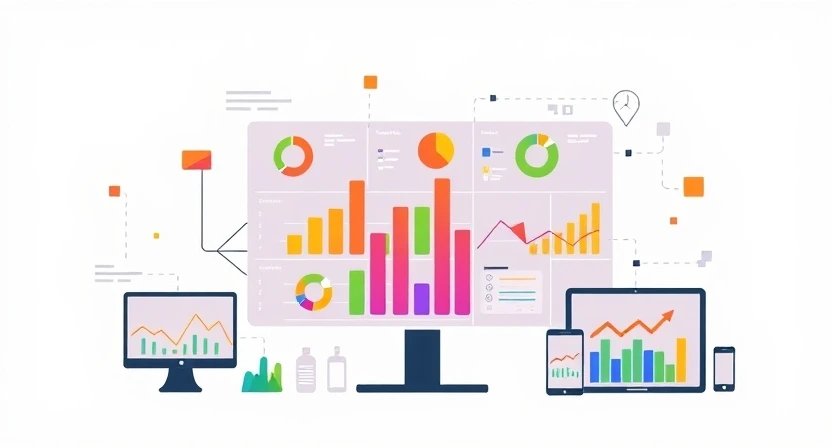Today, digital analytics stands as the only hope for companies that want to succeed in this fast-evolving business world. The reason is simple: it brings clarity to many complex data that businesses use on a daily basis-the ability to decode this messy information into clear, actionable insights-gives businesses the hands they need to swing at all patterns and trends that affect them head-on.
The benefits of digital analytics lie in the ability of businesses to use tools that support data-driven decision making, improvement in customer experience, and optimization of marketing channels. For instance, through digital analytics, a business would know how customers are interacting with it, which pages of the website actually attract the most traffic, and which points are most likely to lose interest. Subsequently, adjustments may be made to these strategies to improve engagements and drive more customers in.
Digital analytics may lead companies to make long-term strategies based on it. It will help the decision-makers track some performance metrics in a better manner and help get the ROI for marketing campaigns. This way, companies can reduce costs, become more efficient, and gain a competitive advantage in the market through data-driven insights.
Digital analytics, in principle, can help businesses have a better understanding of their customer, operate efficiently to achieve revenue growth maximization. An investment into the digital analytics tool makes raw data intrinsically worth more due to its ability to create more value added in making smarter choices that work for the businesses in a sustainable way.
Better Customer Understanding
This means that business can track customer behavior online, know who they are, what they prefer, and what they do in relation to the brand on the web. By tracking page views, session durations, bounce rates, and conversion rates, companies can identify patterns that reveal customers’ likes, dislikes, and habits.
This understanding is a must in being able to craft a customized customer experience. A company can use digital analytics, thus creating a tailored marketing message that will resonate with each group by segmenting its audience by behaviors and preferences. For example, an e-commerce site may use analytics and make special offers in targeting frequent shoppers and recommending products similar to what they have browsed before. This repeated visit elicits customer loyalty.
Tracking the customer journey in this way also allows companies to identify points of pain. For example, if analytics indicate that users are abandoning their shopping carts at a certain point, the business can go and determine why that is the case and find ways to correct it, such as by simplifying the checkout process. Businesses can thus act on such findings to offer a much smoother and enjoyable experience that is aligned with the customer’s expectations.
In a nutshell, cutting-edge customer knowledge through digital analytics will allow companies to present even more relevant, engaging, and satisfying experiences to the consumer. By taking advantage of data-driven insights, businesses can develop stronger customer relationships and build loyalty.

Maximized Marketing Strategy
Perhaps the most influential power derived from digital analytics is its capacity to optimize and enhance marketing strategy. Through digital analytics tools, organizations can monitor their campaigns in real time, know which channels are making maximum engagement, and understand which content the intended audience finds most appealing. Such visibility empowers marketing teams to focus on high-impact strategies while removing ineffective efforts.
For instance, an analytic report shows that the majority of the traffic is coming through social channels and not paid ads; therefore, marketers will spend more money on social channels. Another example is companies can conduct A/B testing-a method, which is often driven by analytics to have proof about the differences in ad creatives, email subject lines, or landing pages. In this manner, businesses know what to improve in order to increase their conversion rates and procure a better ROI.
Third, digital analytics reveals customer preference and behavior, allowing more relevant content to be created, aligned to his personas. As business knows what appeals to the audience, targeted messages will be delivered that will capture attention and provoke action. And through such precision in marketing, costs are decreased, and effectiveness maximized-this is how every marketing dollar spent is well spent.
In other words, this means it makes marketing transition from guesswork into a strategic, data-driven practice. Thus, with the use of optimization into marketing channels using data, companies are better at reaching their ideal customers to increase conversion and achieve brand loyalty.
Better User Experience (UX)
An excellent user experience that is smooth and engaging is very important in the acquisition and retention of customers. The digital analytics insights are availed to contemporary business organizations for informing website design and functionality as well as content so that users can have a seamless experience. Analyzing the interactions or clicks, scrolls, and time spent on pages will easily enable companies to identify what facilitates or hinders the journey of the user with the organization.
For instance, maybe analytics data reveals that a particular page is experiencing a high bounce rate. Such a discovery might indicate a problem with either the content or the layout. This addresses issues that can allow a company to create a more intuitive and enjoyable interface that keeps visitors interested. Similarly, heatmaps-the graphical form of user interaction-can pinpoint areas on a given webpage that receive the most attention and thus help guide how individuals will fine-tune improvements for easier navigation and accessibility.
Another key benefit of UX with digital analytics is A/B testing, in which two versions of a webpage are compared to determine which performs best. With data from those tests, businesses incrementally improve their website to optimize for conversions-a simple change to a button placement or simplification of a form or refinement of a product description.
In conclusion, digital analytics allows businesses to enhance UX by making data-informed changes to their websites and apps. These improvements serve to improve customer satisfaction but also increase engagement and, hence, better performance.

Better Decision-Making and Strategy Formulation
In a world of such acute cutthroat competition, firms need to be highly informed to remain relevant. The power of digital analytics lies in guiding a firm’s decision-making and even strategy planning through transforming raw data into actionable insights. For instance, information relating to acquisition cost, lifetime value, and conversion rates makes it easy for businesses to see where they are going wrong.
Digital analytics can further take the branch of predictive analytics, which predicts future trends. Based on historical data, firms will be able to predict demand for specific products and notice seasonal patterns. Even potential challenges will be predicted. Such company insights give them power to prepare beforehand and take proactive decisions, owing to the market conditions.
Thus, digital analytics encourages interdepartmental collaboration because information shared across departments enables marketing to better target the ads, product teams improve their offerings for customers using sales data analysis, and mainly use the insights drawn through analytics to perform improvements on the basis of customer feedback. This way, it helps bring focus toward the objectives of the business.
In essence, digital analytics provides a more solid foundation for decisioning: data-backed decisioning. With the right data, businesses can move ahead; structure the company’s resources in such a way that there is clear direction; respond quickly to shifts in the market; and ultimately position the business for sustainable growth.
Higher Sales and Revenue
With digital analytics, it would be possible for a company to track and capitalize on various areas to enhance sales and increase revenue. Analytical tools make it possible for companies to track the customer’s journey, starting from the discovery of a product to the time of purchase. Businesses can optimize their sales funnels with clear visibility into all those things blocking conversions.
Another critical aspect is personalization. Analytics insights inform business entities which offers, products, or messages appeal to specific customer segments. Personalized recommendations enhance conversion and upsell chances. For instance, an online retailer can provide with relevant, complementary products to that user based upon previous purchases made, and thus the average order will be increased.
Other than showing patterns for a business to strike a perfect price, identify the most sold items and when to consider running promotions, digital analytics can also depict behavioral patterns about a company’s buy choices. They can make forecasts based on historical sales data of when peak periods will occur and get ready as such for their stock to be full in all aspects.
In summary, digital analytics propels revenue growth through improvement of conversion rates, personalization of customer interactions, and optimizing price strategies. The adoption of a data-driven approach empowers the business to make smarter choices that improve sales performance and profitability.
Conclusion
All these solutions come with a good mix of benefits derived by businesses, such as improving customer understanding, optimized marketing, enhanced sales, and support for a secure online environment. Digital analytics tools are investments from which companies can tap into valuable data, fuel smarter decisions, and drive long-term growth.
As business continues to adapt more in digital transformation, analytics will keep proving invaluable, by supporting their decisions in business and as an element of competitive advantage. In an ever-changing market, having digital analytics empowers businesses to remain agile, change to meet shifting customer needs, and drive sustainable success. For any company looking to thrive in the digital age, incorporating digital analytics is a plus-it’s a must.
Related Post
Impactful Strategic Growth: The Art of Analyzing Competitor Ads






